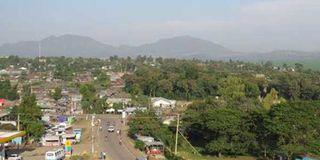Homa Bay leads country in HIV/Aids cases, new study says

A view of Homa Bay Town. A new study shows that Homa Bay County bears the largest brunt of the HIV/Aids scourge in Kenya with Mbita Sub-County having the highest number of HIV/Aids individuals at 23 per cent. FILE PHOTO | NATION MEDIA GROUP
What you need to know:
- Mbita Sub-County's high number is attributed to the fishing industry, the study said.
- Middlemen known as “jaboya” give women fish in exchange for sex.
- On Tuesday last week, the National Aids Control Council took its campaign to Rusinga Island, Mbita Constituency.
- It took advantage of the annual Rusinga cultural festival to offer free HIV testing and counselling.
Homa Bay County bears the largest brunt of the HIV/Aids scourge in Kenya, a study has shown.
Out of the 1.6 million people with HIV/Aids in the country, 10 per cent or 159,970 were in Homa Bay in 2013 as were 4,629 people or 10 per cent of the national total who died of Aids-related complications.
According to the First Homa Bay Multisectoral Aids Strategic Plan (2014/2015-2018/2019), the main drivers of HIV/Aids the eight sub-counties are poverty, cultural and sexual attitude and behaviour, the fishing industry networks, lifestyle related factors, health risk behaviour and professional related issues.
Mbita Sub-County has the highest number of HIV/Aids individuals at 23 per cent.
The sub-county’s high number is attributed to the fishing industry, the study said.
Middlemen known as “jaboya” give women fish in exchange for sex.
On Tuesday last week, the National Aids Control Council took its campaign to Rusinga Island, Mbita Constituency.
It took advantage of the annual Rusinga cultural festival to offer free HIV testing and counselling.
CONDOMS FOR FISHERMEN
The council also distributed condoms to residents, especially those in the fishing industry.
The council’s HIV prevention expert Joab Khasewa said the drive was as a result of the worrying statistics.
“We are providing these services for free,” Mr Khasewa said.
He added that the council is determined to inform HIV/Aids patients on the need for continued antiretroviral therapy.
Aids expert Ben Otieno said when treatment breaks, the viral load goes up very fast while the CD4 count drops significantly.
“When HIV positive people stop taking ARVs, they may have the same symptoms like the ones they had when they were newly infected,” Dr Otieno told residents.
He added that when the patients go back to medication after taking a break, they may experience more side effects.
According to Dr Otieno, the patients might also have difficulties in adhering to taking their doses correctly.
“Anti-retroviral therapy shouldn’t be interrupted without the advice of healthcare providers as viral load and CD4 cells levels should be carefully monitored,” he said.




